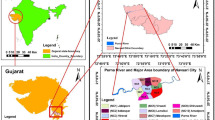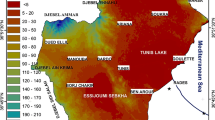Abstract
In this study, Technique for Order of Preference by Similarity to Ideal Solution (TOPSIS) and Analytic Hierarchy Process (AHP) methods were used to determine, prioritize, and assess the most effective desertification indices. A list of 32 influential indices was identified using existing literature in Iran and around the globe through questionnaires. Criteria for evaluating indices were weighted using Shannon entropy, and then TOPSIS ranking method was applied to determine the most effective desertification assessment to deal with this issue in Kashan region, Isfahan province. Indices were weighed and prioritized by analytics hierarchy process. Finally, the Mediterranean Desertification and Land Use (MEDALUS) model was used to assess the intensity and develop a desertification risk map. The results asserted that sensitivity to minor changes with a weight of 0.341 has the highest importance, while time and cost with a weight of 0.11 has the least importance for the evaluation of indices. Among the 32 ranked indices, 20 of which were identified as the most effectual indices including annual precipitation, salinity, and vegetation, to name a few. The results also showed that the land use change index with a weight of 0.217 and annual rainfall with a weight of 0.166 have the highest priority among human and natural indices that should be prioritized in managing and controlling desertification. The average weight of quantitative desertification intensity for the whole area was 1.391 placed in critical (1) class of desertification. Among the six considered desertification criteria, the climate and the destruction of water resources were the most important criteria.








Similar content being viewed by others
Notes
Environmentally sensitive areas to desertification
Modified Iranian Classification of Desertification
Modified Iranian Classification of Desertification
Iranian Model of Desertification Potential Assessment
Desertification mapping
Ground Water Index
Management Quality Index
Soil Quality Index
Vegetation Quality Index
Climate Quality Index
Wind Erosion Index
Water Erosion Index
References
UNCCD. (2005). Adoption of the agenda and organization of work, ICCD/COP (7)/CST 1, 15 pp.
Zehtabian, G., Khosravi, H., & Masoudi, R. (2014). Models of desertification assessment (criteria and indices). Tehran: University of Tehran Press.
Sadeghiravesh, H., Reyahi, K., & Khosravi, H. (2012). Zoning wind erosion potential risk in central iran using modified numerical taxonomy model. American-Eurasian Journal of Agriculture and Environment Science, 12(1), 91–99.
Aazarian, F., Valizadeh, S., Dehghan, P., & Khosravi, H. (2017). Assessment and mapping desertification risk in Roudab region. Journal of Range and Watershed Management, 69(4), 789–804.
Joachim, H., & Jacques, M. (2007). Land degradation and soil erosion mapping in a mediterranean ecosystem. In H. Joachim, M. Wolfgang, & A. Michael (Eds.), imaging spectrometry, a tool for environmental observation (pp. 237–260). Dordrecht: Springer.
Kadovic, R., Bohajar, Y., Perovic, V., Simic, S. B., Todosijevic, M., Tosic, S., Andelic, M., Mladan, D., & Dovezenski, U. (2016). Land Sensitivity analysis of degradation using MEDALUS model: case study of Deliblato Sands, Serbi. Journal of Archives of Environmental Protection, 42(4), 114–124.
Lahlaoi, H., Rhinane, H., Hilali, A., Lahssini, S., & Moukrim, S. (2017). Desertification assessment using MEDALUS model in Watershed Oued El Maleh, Morocco. Journal of Geosciences, 50(7), 2–16.
Tavakoli, M., Nourinejad, S., & Rostamin, S. (2018). Evaluation and comparison of ICD and ESAs models for desertification zonation in Mehran plain, Ilam. Iranian Journal Rangeland and Desert Research, 24(4), 821–830.
Hosseinpour, R., Onagh, M., Komaki, B., & Gask, M. R. (2017). Hazard assessment of desertification using the MICD model: a case study of Kaji pond watershed in Nehbandan, Iran. Journal of Desert Ecosystems Engineering, 14(6), 33–44.
Silakhori, E., & Vahabzadeh, G. (2017). Assessment of desertification intensity in Roudab Sabzevar area by using MICD Model. Journal of Geography, 7(2), 59–77.
Kamali Maskooni, E., Kamali, M. A., Amiri, I., & Zare, M. (2015). Study of desertification status using IMDPAModel with emphasis on water, soil and vegetation criteria (case study: Faryab-Kerman Province). Journal of Biological Forum, 7(1), 1149–1155.
Rafi Sharif Abad, J., Noheghar, A., Zehtabian, G., Khosravi, H., & Gholami, H. (2016). Study of desertification status based on a sub-IMDPA model for a case study in Yazd-Ardakan plain, Iran. International Journal of Forest and Erosion, 6(3), 73–81.
Sadeghiravesh, M., Khosravi, H., & Ghasemian, S. (2016). Assessment of combating-desertification strategies using the linear assignment method. Solid Earth, 7(2), 673–683.
Pourtaheri, M. (2014). Application of multi-attribute decision-making methods in geography. Tehran: The organization for Researching and Composing University Textbooks in the Humanities.
Momeni, M. (2006). New topics in operations research. Tehran: University of Tehran.
Aldian, A., & Taylor, M. (2005). A consistent method to determine flexible criteria weights for multicriteria transport project evaluation in developing countries. Journal of the Eastern Asia Society for Transportation Studies, 6, 3948–3963.
Saaty, T. L. (1980). The analytic hierarchy process. New York: McGraw-Hill International.
Sadeghiravesh, H., & Zehtabian, G. (2010). Assessing desertification strategies using AHP model and preferential prioritization techniques based on similarity to ideal responses (TOPSIS). Journal of Natural Sciences and Techniques, 16(56), 241–261.
Sadeghiravesh, M., Zehtabian, G., & Khosravi, H. (2014). Application of AHP and ELECTERE models for assessment of de_desertification alternatives. Journal of Desert, 19(2), 141–153.
Grau, J. B., Anton, J. M., Tarquis, A. M., Colombo, F., de los R’os, L., & Cisneros, J. M. (2010). An application of mathematical models to select the optimal alternative for an integral plan to desertification and erosion control (Chaco Area – Salata Province – Argentina). Biogeosciences, 7, 3421–3433.
Sepehr, A., & Zucca, C. (2012). Ranking desertification indices using TOPSIS algorithm. Journal of Natural Hazards., 62(3), 1137–1153.
Pishyar, S., Khosravi, H., Tavili, A., & Malekian, A. (2018). Desertification risk mapping based on water resources degradation using multi criteria decision-making, case study: Kashan Plain. Journal of Water and Soil Science, 21(4), 71–84.
Sabouri, R. S., Nazari Samani, A. A., & Sepehr, A. (2016). Determining the most important indices of desertification based on the concept of DPSIR and multi- criteria decision- making techniques (case study: Fayz Abad Intervention). Journal of Earth Science Researches, 4(3), 34–39.
Mavi, R. K., Goh, M., & Mavi, N. K. (2016). Supplier selection with Shannon entropy and fuzzy TOPSIS in the context of supply chain risk management. Procedia-Social and Behavioral Sciences, 235, 216–225.
Filar, J. A., Ross, N. P., & Wu, M. (2003). Environmental assessment based on multiple indicators. Calcutta Statistical Association Bulletin, 54, 93–99.
Hwang, C. L., & Yoon, K. (1981). Methods for multiple attribute decision making. In, Multiple attribute decision making (pp. 58–191). Heidelberg: Springer
European Commission. (1999). Mediterranean desertification and landuse (MEDALUS). Landen: MEDALUS office.
Sepehr, A., Hassanli, A. M., Ekhtesasi, M. R., & Jamali, J. B. (2007). Quantitative assessment of desertification in the south of Iran using MEDALUS method. Environmental Monitoring and Assessment, 134, 243–254.
Sadeghiravesh, M., Khosravi, H., & Ghasemian, S. (2015). Application of fuzzy analytical hierarchy process for assessment of combating-desertification alternatives in central Iran. Natural Hazards, 75(1), 653–667.
Vesali, S. A., Zehtabian, G., & Azarnivand, H. (2016). Determination of the most effective indices of water and irrigation criteria in desertification intensity (case study: Kashan and Aran Bidgol plains). Journal of Desert Management, 6, 25–38.
Author information
Authors and Affiliations
Corresponding author
Additional information
Publisher’s Note
Springer Nature remains neutral with regard to jurisdictional claims in published maps and institutional affiliations.
The paper is a part of the M.Sc. thesis of the first author conducted at the University of Tehran.
Rights and permissions
About this article
Cite this article
Pishyar, S., Khosravi, H., Tavili, A. et al. A Combined AHP- and TOPSIS-Based Approach in the Assessment of Desertification Disaster Risk. Environ Model Assess 25, 219–229 (2020). https://doi.org/10.1007/s10666-019-09676-8
Received:
Accepted:
Published:
Issue Date:
DOI: https://doi.org/10.1007/s10666-019-09676-8




